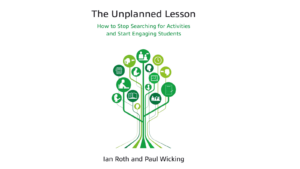by Elizabeth Bekes
Book Review
Emma Riordan: Language for Teaching Purposes
Bilingual Classroom Discourse and the Non-Native Speaker Language Teacher
2018, Palgrave Macmillan
https://doi.org/10.1007/978-3-319-71005-1_1
“This book examines the spoken language needs of non-native speaker language teachers (NNSLTs),” is the very first sentence in Emma Riordan’s book. It instantly piqued my interest, because the word “English” was missing (so we are not talking about NNESTs here), and also because in recent years there has been an intense debate about the desirable language proficiency levels of non-native English speaker teachers.
As a Hungarian English teacher, I belong to this group, whose numbers I would put at 10 million (roughly the population of my native land). Guesswork aside, there are millions of us, with a large proportion teaching monolingual groups in non-immersion settings; an army of educators whose special needs to learn language for teaching purposes are the book’s primary concern.
Riordan carried out her research among native English-speaking teachers of German at post-primary schools in Ireland, but the results of her study are transferable. She looks at language teachers as the learners of a specific genre, namely, classroom language (used as a foreign language), which is complicated by the fact that the target language is not only the object of study, but also the means of communication.
Raising language teachers’ proficiency is often questioned on the grounds that it is time-consuming (e.g., set at 200 hours of lessons and supervised study to get from B2 to C1) and, therefore, not cost- effective in terms of human endeavour. Why not, instead, invest a fraction of this amount of time in training up teachers to use more effective language teaching approaches or innovative learning techniques, goes the reasoning.
The novelty of Riordan’s writing is that she convincingly argues that this does not need to be an irreconcilable dichotomy. Language use for specific purposes has been part of the learner-centred needs analysis based trend for decades now (ESP in our case).
Why not look on what language teachers have to perform as a sub-case of Language for Specific Purposes (LSP), namely, Language for Teaching Purposes (LTP)?
Suddenly, the skills and the content of what NNSLTs need to acquire appear to be more easily manageable and more focussed for the purposes of curriculum design for trainee teachers or for those looking to continuous professional development by improving their language skills by specifically concentrating on the tasks they need to perform in the classroom.
Riordan does not shy away from the challenges or controversies. She acknowledges that the activities and the speech acts that take place in the foreign language classroom are not too often replicated in the real world. Such is the typical initiation-response-feedback (IRF) sequence, where the teacher asks for a response and gives feedback on the answer. However, the teaching / learning process takes place in an authentic environment (the classroom itself), which has its specific discourse.
The author emphasizes that this creates at least two further difficulties: the non-native language teacher may not have been socialized in the education system of the target language (even if she was a student in that language community, she was not in the role of the teacher), and it is questionable how far classroom language – or classroom-generated utterances – can be useful for the students themselves in the long run. After all, following an exchange like this, where the teacher has asked students what they would buy with one dollar, the reaction in real life to the student’s answer would be probably quite different:
T uh, what would you buy, uh, Chris?
P a machine gun.
P2 what?
T YOU SAY IT TO ME IN A COMPLETE SENTENCE. “ I would buy a machine gun,” ok, steven?
(p. 71, taken from Seliger and Long, 1983)
Nevertheless, Riordan builds up her arguments in a compelling manner. If we acknowledge that student-centred and needs analysis based methods are more effective, and LSP can better cater for that, furthermore, we accept that the language class constitutes a discourse community and classroom language is a special genre, we can then look at classroom discourse and the nature of teacher talk in a more structured manner and focus on aspects that are eminently useful as well as increase the confidence of non-native teachers, leading to a more relaxed attitude which, in turn, is more conducive to learning.
The author pays special attention to the nature and role of teacher questions. The difference between display and referential questions is treated with regard to how NNSLTs in the research sample were more inclined to use display questions (to which the teacher knew the answer), while open referential questions (to which students could supply answers that the teacher would not be able to anticipate) were employed a lot less, even though such questions usually give rise to answers requiring both higher order thinking skills and utterances of a more personalized nature.
There are a number of other interesting issues raised by the author with regard to non-native speaker teachers, for example, corrective feedback (the problem of not spotting a mistake, or not providing a clear explanation for the correction); the teacher as a role model of a successful target language learner (including mistakes that the teacher might make); the principled use of L1 in non-immersion contexts and monolingual L1 groups; and the non-native language teacher’s self image and language anxiety, just to mention a few.
Obviously, since Riordan’s research was conducted in Ireland and looked at non-native speaker German teachers, the issues pertaining to teaching English are only touched upon but not dwelt on. However, the takeaway message is well-grounded and thoroughly researched.
Language for Teaching Purposes is a special category of Language for Specific Purposes, and treating it as such could lead to the design of curricula that take into account the needs of non-native teachers to perform the tasks associated with teaching the target language successfully by using that target language to communicate authentically in the classroom and to prepare their students for encounters outside the classroom. And that might involve spending your one dollar wisely.
Seliger, H. W., & Long, M. H. (1983). Classroom oriented research in second language acquisition. New York, NY: Newbury House.




